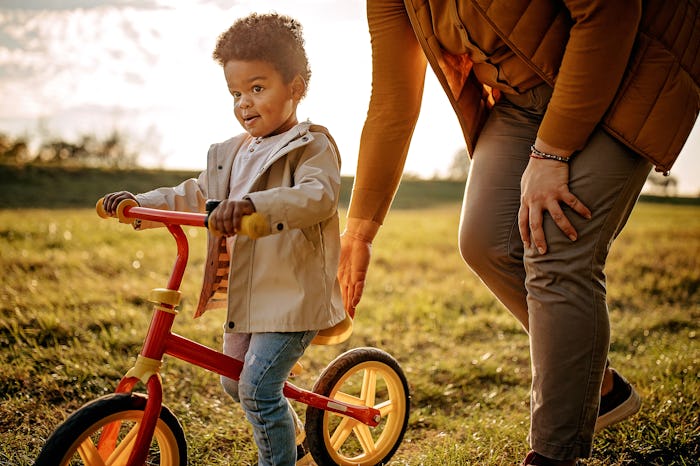Little Kid

How To Figure Out What Size Bike Your Kid Needs
Knowing your kid's height and weight helps, but don't forget that they love streamers and a basket, OK?
With the holiday season on the horizon, a new bike might be at the top of your child's wish list. (A red one, to be exact.) But without having them try it out, how do you know what size bike to get your kid? Which one will fit them like a glove and not be outgrown in a few short months.
While many bikes are labeled with the suggested ages of the rider, your child's height and weight are the main factors to take into consideration when choosing the right size bike. "Each child is unique — growing at a different rate, with a different body type, etc," Kris Parlett, Marketing Director with United Wheels, Inc., the holding company of leading retail brand Huffy tells Romper. "For that reason, the same age child may seem right for more than one bike."
If you're trying to surprise your child with a brand new ride, they likely won't be in tow when you're shopping. Without the ability to sit on the bicycle to try it out, it might seem difficult to know exactly which size bike fits your child's needs. Luckily, Huffy has a handy chart you can reference to see which size bike will work best for your little one.
When it comes to bicycle sizing, it's worth mentioning that the "size" of the bike — 12", 14", etc. — actually refers to the wheel diameter. Most bicycles meant for kids will fall within the 12" to 20" range.
"Riding the proper size bike provides a safe, controlled ride," Parlett says. "A bike that is too big or too small means it's awkward to reach the pedals and handlebar, and harder to control when riding – especially when turning or applying the brake."
Parlett compares fitting a bicycle for your child to driving a car with regard to the adjustments that may need to be made to your child's bike seat or handlebars in order to get the perfect ride. "It’s the same as driving a car," Parlett says. "When we first get in a car, we adjust the seat, steering wheel, mirrors, etc., to make sure we have the right reach and view. Once those are set, we are in a safer position to drive."
With this in mind, if your child falls between bicycle sizes, it's worth taking a look at how the seat can be adjusted to see how the bicycle might work for your child after all. "While it’s tempting to 'size up,' the right fit is important for the child’s ability to control the ride. Most bikes include an adjustable seat-post, which helps the bike grow with the child," Parlett says. "That allows parents to buy the right size bike for the child and raise the seat height as the child grows."
Bicycle riding is such a huge milestone in a child's life. The freedom that comes with learning to ride a two-wheeler officially ushers in the "big kid" stage. Especially if this is your child's first bike, it's important to get the sizing just right. They'll need to be able to maintain proper balance while learning to ride, so you don't want a bike that's so big their feet can't reach the ground when they're seated.
"To determine the correct seat height, have the child sit on the bike with one leg down in the '6:00' position, with the knee slightly bent. The other leg should be bent to the '3:00' position, with the knee over the ball of the foot," Parlett says. "When both legs are in the right position, you’ve found the right seat for secure control and momentum."
While fit is of the utmost importance, when you're shopping for a bike (especially the kind your kid will wake up to on Christmas morning), style is another key factor to consider. "Keep in mind what colors and styles of clothes, backpacks, sporting goods, and other things your child likes when picking out a bike," Parlett says. "A bike is an extension of the child’s personality – from fun patterns and butterflies to fantasy and racing."
You'll want to continue to keep an eye on the fit of your child's bike once they've started to ride it regularly. As they grow, their bike may need to be adjusted or even replaced. Parlett has an easy-to-remember guideline: "When a child starts to outgrow clothes, it’s time to check the bike!"
Expert:
Kris Parlett, Marketing Director, United Wheels, Inc.
This article was originally published on